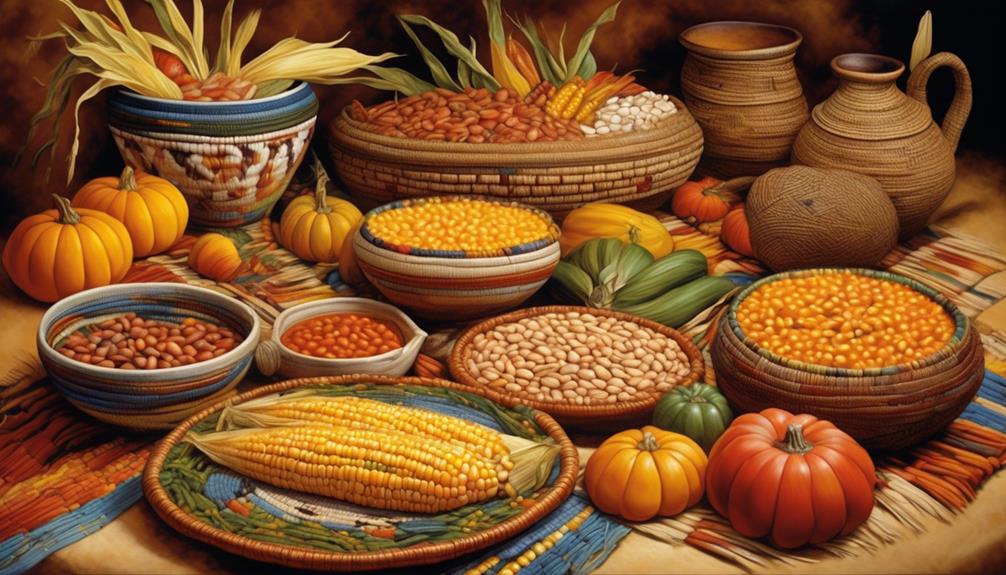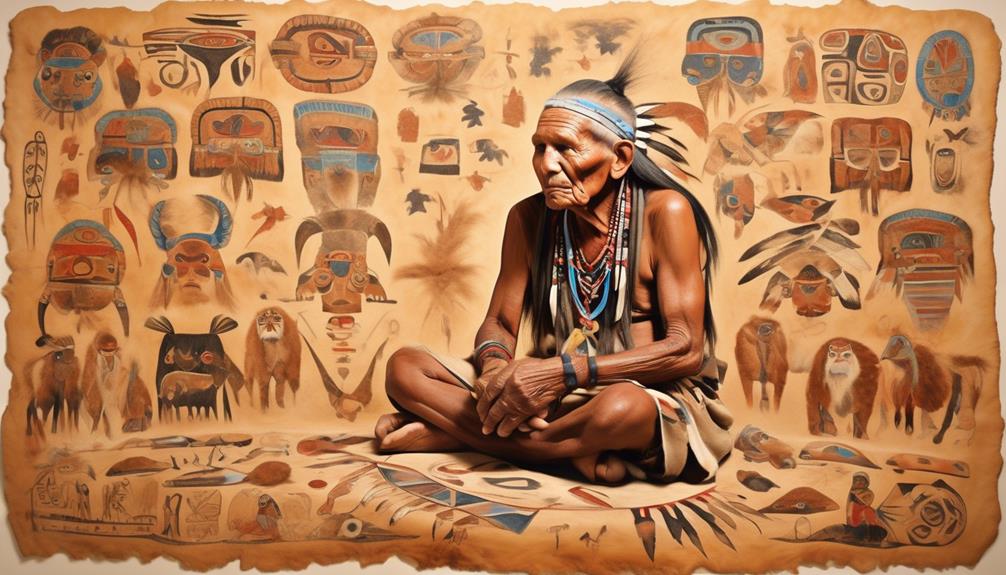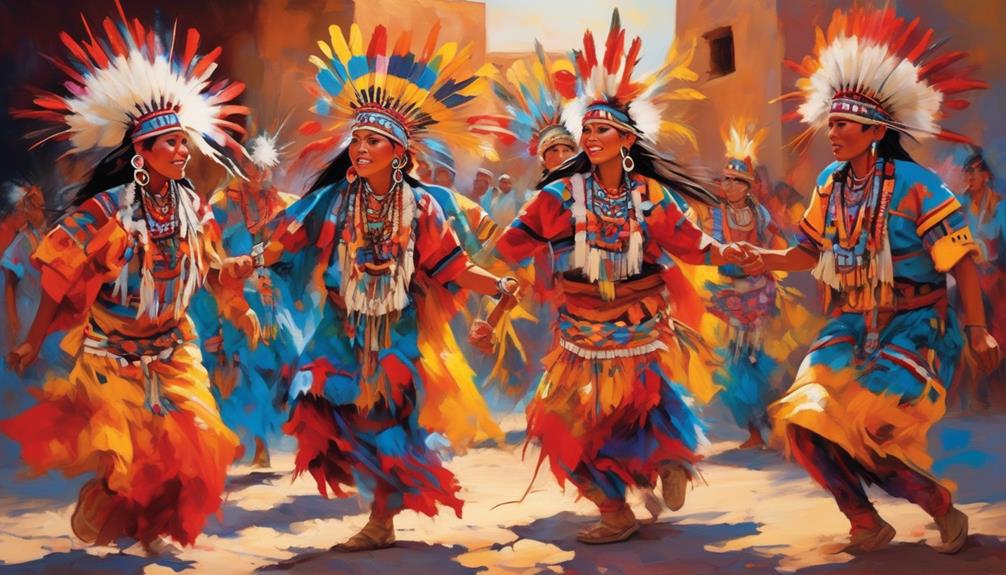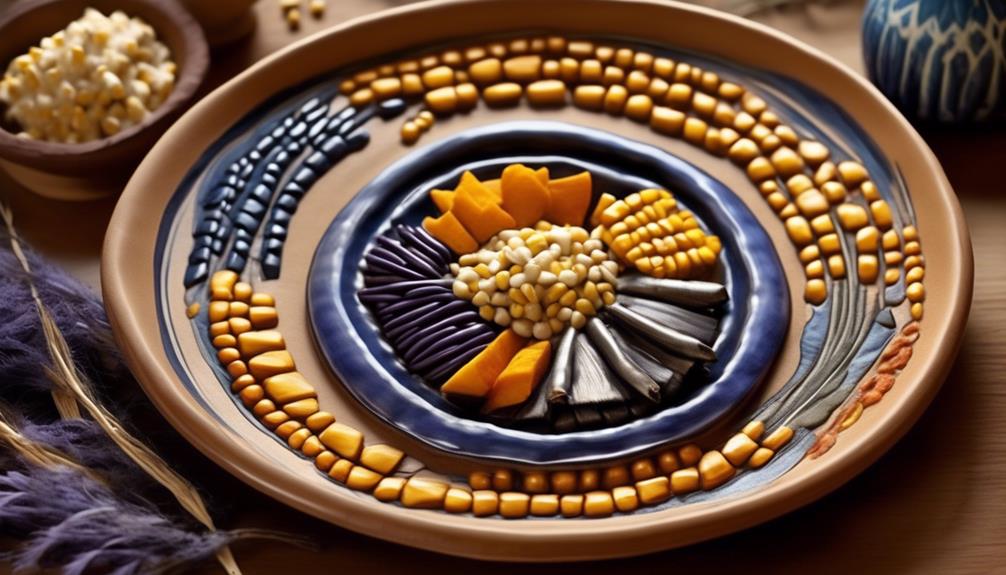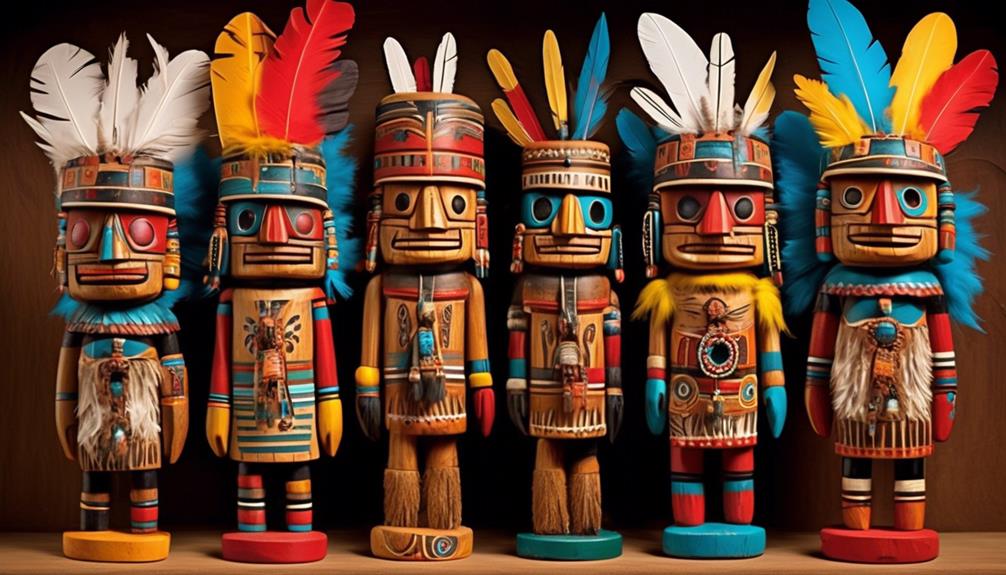I had the chance to delve into the customs of a Hopi tribe, and I was astonished by the diverse array of their classic dishes. One meal stood out especially – a corn stew blended with fragrant herbs and succulent venison chunks, making a lasting impact on us. Dive into the unique culinary world of the Hopi tribe and uncover hidden gems that will tantalize your taste buds.
The deep connection between the Hopi people and their land is reflected in their diet, which comprises staple crops like corn, beans, and squash, along with a diverse array of wild-harvested plants and meat from animals that roam the high desert.
The way they honor their culinary practices and traditions is truly fascinating, and it's clear that there's much more to uncover about the Hopi tribe's unique approach to food.
Key Takeaways
- Piki bread and Pikiwan porridge are traditional Hopi foods made from blue cornmeal, ash, and water, serving as a cultural symbol and fostering a sense of community and tradition.
- Staple crops like corn, beans, and squash are fundamental to Hopi diet, symbolizing fertility, life, and spirituality. Melons, such as watermelon and cantaloupe, are also enjoyed during communal gatherings.
- Wild harvested foods like wild berries, mesquite beans, prickly pear cactus, pinon nuts, and wild greens provide additional nutrition and flavor to Hopi cuisine.
- Meat and protein sources include deer, rabbit, and quail, obtained through hunting practices. Dietary restrictions based on traditional beliefs emphasize a balance between plant-based proteins and animal proteins.
Hopi Traditional Foods
Exploring the rich culinary heritage of the Hopi tribe reveals a diverse array of traditional foods that are deeply rooted in their cultural and spiritual practices. Traditional recipes hold immense cultural significance for the Hopi people, as they aren't just a source of sustenance, but also a way to connect with their ancestors and honor their traditions.
One such staple is piki bread, a paper-thin, delicate bread made from blue cornmeal and ash. This time-honored recipe involves a meticulous process of grinding the corn, preparing the batter, and skillfully spreading it over a hot stone.
Another iconic dish is pikiwan, a porridge made from ground corn, juniper ash, and water, symbolizing fertility and prosperity. The Hopi also value the use of native ingredients like beans, squash, and sunflower seeds in their traditional recipes, reflecting a deep understanding and respect for the land.
These traditional foods not only nourish the body but also serve as a link to the Hopi's cultural identity, fostering a sense of community and tradition.
Staple Crops and Vegetables
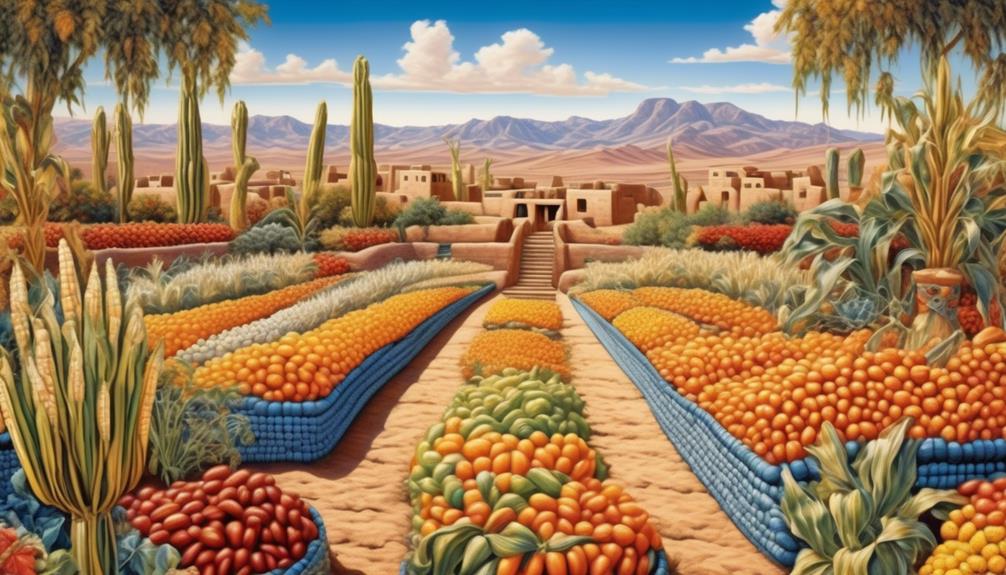
What role do staple crops and vegetables play in the traditional cuisine of the Hopi tribe?
Staple crops and vegetables are essential components of the traditional Hopi diet, providing sustenance and cultural significance. Corn, known as 'motha' in the Hopi language, is a fundamental staple, forming the basis of many traditional dishes. The importance of corn is deeply ingrained in the Hopi culture, symbolizing fertility, life, and spirituality.
Beans are another crucial crop, complementing corn to form a balanced source of protein and essential nutrients. In addition to corn and beans, squash and melons are also integral to Hopi cuisine. Squash varieties such as yellow and green summer squash, as well as winter squash like acorn and butternut, are cultivated and feature prominently in traditional recipes.
Melons, including watermelon and cantaloupe, are cherished for their sweetness and refreshing qualities, often enjoyed during communal gatherings and ceremonies. The combination of these staple crops and vegetables reflects the Hopi people's holistic approach to nutrition, emphasizing a balance of essential nutrients and the preservation of cultural traditions.
These crops not only sustain the body but also nourish the spirit, reinforcing the interconnectedness of the Hopi people with the land and their heritage.
Wild Harvested Foods
Wild harvested foods, gathered from the diverse landscapes of the Hopi territory, contribute to the rich tapestry of traditional cuisine and provide essential sustenance for the community. The Hopi people have a deep connection with the land and have developed intricate foraging techniques to gather a variety of wild foods throughout the changing seasons. These wild harvested foods are not only a source of nutrition but also hold cultural and spiritual significance for the tribe.
| Wild Harvested Foods | Seasonal Availability | Preparation |
|---|---|---|
| Wild Berries | Summer | Eaten fresh or dried for later use. |
| Mesquite Beans | Fall | Ground into flour for baking. |
| Prickly Pear Cactus | Late Summer | Peeled and eaten raw or used in salads. |
| Pinon Nuts | Late Summer | Roasted and eaten as a snack or ground into meal. |
| Wild Greens | Spring | Cooked or eaten fresh in salads. |
The Hopi people have a profound understanding of the seasonal availability of these wild foods and have incorporated them into their traditional recipes for generations. By carefully foraging and honoring the natural cycles, the Hopi have sustained themselves with an array of wild harvested foods, ensuring a diverse and nutritious diet throughout the year.
Meat and Protein Sources
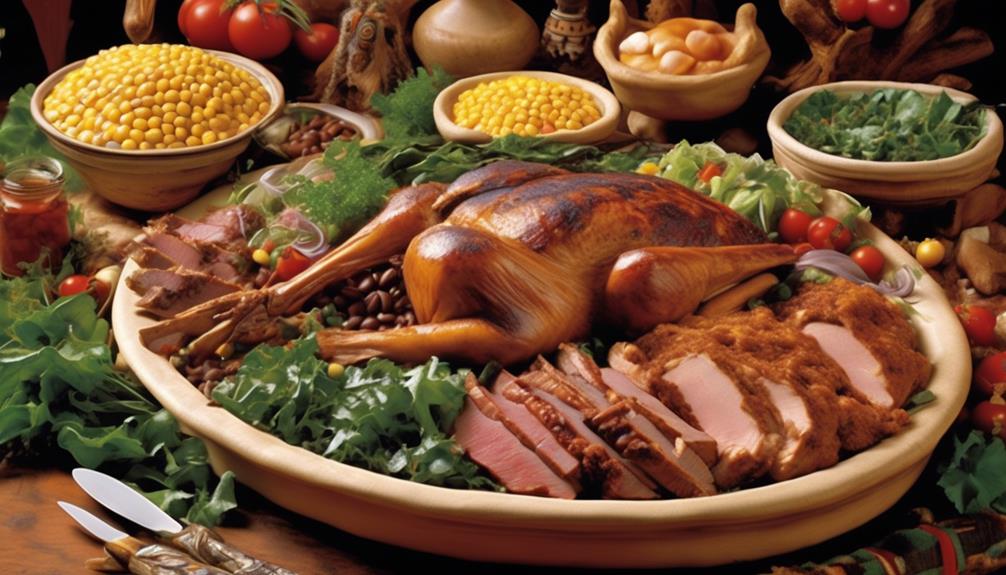
Foraging the diverse landscapes of the Hopi territory hasn't only provided a rich tapestry of wild harvested foods but has also shaped our traditional cuisine, encompassing a variety of meat and protein sources essential for our sustenance.
Hunting practices play a significant role in our meat and protein sources. The Hopi people have long relied on hunting as a means of obtaining meat, primarily focusing on game such as deer, rabbit, and quail. Our hunting practices are deeply rooted in respect for the animals and the land, with rituals and prayers offered to honor the spirits of the animals. This reverence for the act of hunting is an integral part of our cultural and spiritual connection to the natural world.
In addition to hunting, the Hopi diet includes a balance of plant-based proteins such as beans, corn, and squash. It's important to note that our dietary restrictions, rooted in traditional beliefs, guide our consumption of meat. For instance, certain ceremonies and periods of the year necessitate dietary abstentions from specific meats, reinforcing the interconnectedness of our spiritual and physical well-being.
This holistic approach to meat and protein sources reflects the deep cultural significance of food within the Hopi tribe.
Culinary Practices and Traditions
Embedded within our culinary practices and traditions are centuries of knowledge, rituals, and customs that reflect our deep connection to the land and the natural world. Our food preservation techniques, such as drying, smoking, and fermenting, have been passed down through generations, allowing us to sustainably store and consume a variety of foods year-round. These methods not only ensure food security but also honor the spiritual significance of different ingredients.
Our cooking methods, including boiling, steaming, and baking, are deeply intertwined with our cultural identity and relationship with the earth. Traditional clay pots and ovens are still widely used, infusing our dishes with unique flavors and textures while preserving the authenticity of our cuisine. These methods not only demonstrate our resourcefulness but also showcase the harmony between our culinary practices and the environment.
The interplay between food preservation techniques and cooking methods is a testament to our holistic approach to sustenance. By seamlessly blending ancient wisdom with practical innovation, we continue to celebrate and uphold our culinary heritage while adapting to the contemporary world.
Frequently Asked Questions
What Are the Traditional Methods of Food Preservation Used by the Hopi Tribe?
Traditional preservation of food involves using various techniques to ensure long-term storage. These methods have been developed over generations and are integral to preserving the nutritional value of food.
Food storage techniques such as drying, smoking, and fermenting are utilized to maintain the availability of essential sustenance throughout the year.
These traditional methods not only preserve food but also hold cultural significance and reflect the deep connection to the land and heritage.
Are There Any Specific Rituals or Ceremonies Related to Food Preparation and Consumption Within the Hopi Culture?
Food rituals and ceremonial practices hold significant importance within the Hopi culture. While some may question the relevance of these traditions in modern times, they play a vital role in preserving our cultural identity.
The incorporation of modern food doesn't diminish the value of traditional preservation methods, as they continue to be upheld. Women play a crucial role in food preparation, often overseeing the adherence to food taboos and the continuation of these sacred practices.
How Do Hopi Tribe Members Incorporate Modern Foods Into Their Traditional Diet?
Incorporating modern foods into our traditional diet is a delicate balance. We strive to honor our cultural heritage while also adapting to the changing world around us. Our dietary practices reflect this cultural adaptation as we incorporate new foods like wheat flour and canned goods alongside our traditional staples like corn, beans, and squash.
We carefully consider the nutritional value and sustainability of these modern additions to ensure they align with our traditional values.
Are There Any Dietary Restrictions or Taboos Within the Hopi Tribe's Culinary Practices?
We discovered that there are specific dietary restrictions and taboos within the Hopi tribe's culinary practices. Certain foods are prohibited during ceremonial events, like specific animals and plants, and there are guidelines for food preparation and consumption.
These restrictions are essential for maintaining spiritual balance and honoring traditional beliefs. The Hopi dietary restrictions and culinary taboos play a significant role in preserving the cultural heritage and spiritual connection to the land.
What Role Do Women Play in the Preparation and Distribution of Food Within the Hopi Tribe?
In many cultures, women hold a central role in food preparation and distribution. They often bring together ingredients, use food preservation techniques, and ensure that meals are shared among the community.
In contrast, men may have different roles in obtaining ingredients or overseeing certain aspects of food distribution.
Within the Hopi Tribe, women's involvement in food preparation and distribution is deeply rooted in tradition and plays a crucial role in sustaining their community.
Conclusion
In conclusion, the Hopi tribe's diet is a rich tapestry of tradition and sustenance.
Like a patchwork quilt, their staple crops, wild harvested foods, and diverse meat sources come together to create a vibrant and nourishing culinary tradition.
Their culinary practices and traditions are like a thread that weaves their community together, connecting them to their ancestors and the land they call home.
Mary is a passionate writer who brings creativity and a fresh perspective to our team. Her words have the power to captivate and inspire, making her an essential contributor to our content. Mary’s commitment to storytelling and dedication to promoting Indigenous culture ensures that her work touches the hearts of our readers. We’re fortunate to have her as part of our team.
